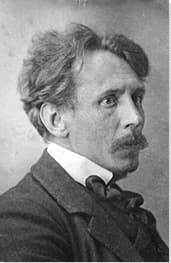Summary of Mikalojus Konstantinas Čiurlionis
Over a short but prolific career, Čiurlionis created a body of work that has secured him the standing of "national treasure" amongst fellow Lithuanians. Having already made his name as a prodigious pianist and composer, he turned to drawing and painting, producing some 300 abstract and semi-abstract works in a six year period cut tragically short by fatal illness.
Little-known outside of Eastern Europe in his own lifetime, Čiurlionis has since earned wider international recognition as an innovator whose voracious appetite for new learnings saw him combine influences drawn from Eastern philosophy, religion and astronomy, with the ancient customs and folklore of his cherished homeland. Čiurlionis's art has seen him aligned primarily with Symbolism and Art Nouveau, with his most famous pieces overflowing with motifs and symbols alluding to spiritual worlds and dream-like apparitions. Combining his love of music and art, Čiurlionis said he wanted people who came to his paintings to experience what he termed "a rising wave of feeling".
Accomplishments
- Čiurlionis is chiefly associated with a field of Symbolism that pursued abstract dimensions through representations of the natural and meta-physical world. It was a characteristic that followed in a specific tradition of Nordic Neo-Romanticism and, with no little help from Čiurlionis, put its stamp on the cultural identity of turn-of-the-century Lithuania and Poland.
- Čiurlionis's pictorial sonatas are associated with theories of synesthesia - the marriage of music and art - and Gesamtkunstwerk - the idea of a "total artwork". Through his Funeral Symphony series (1903), for example, he found a way of presenting a poignant reminder of the fragility of life and the power of art to capture aspects of the variety of human experience.
- Čiurlionis' works regularly addressed mankind's place in the universe, and specifically our relationship with an omnipotent heavenly deity. With his signature figure, Rex, for example, Čiurlionis conjured a universal God-like figure and spirit guardian who featured across many of his mature paintings. Speaking of his Creation of the World series, Čiurlionis clarified his inner vision when he wrote, "This is the Creation of the World, not of our world according to the Bible, but another, fantastical world".
- As a Lithuanian artist, Čiurlionis infused his work with a deep feeling for his homeland's topography. He took great personal and national pride in his natural surrounding and sought to recreate through his art the emotional bliss he had himself experienced. For example, the colors and motifs in works such as Truth (1905) evoke the natural majesty of the rolling hills and vast forests that provided the backdrop for the artist's own upbringing.
The Life of Mikalojus Konstantinas Čiurlionis
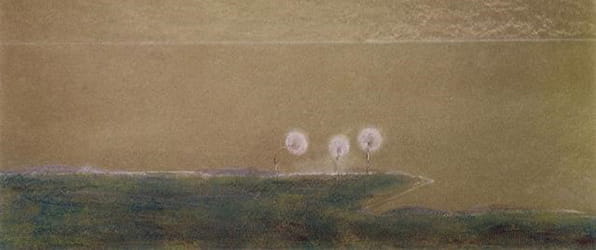
The influential Russian art critic Alexandre Benois referred to Čiurlionis as "a genius cursed by fate, one of those true geniuses, mythmakers, who create works of sublime, ineffable meaning".
Important Art by Mikalojus Konstantinas Čiurlionis
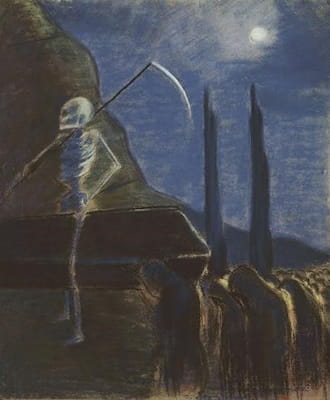
Funeral Symphony (V)
Part of his first cycle of paintings, Funeral Symphony allowed Čiurlionis to represent a procession of ideas that incorporated his expansive knowledge of music, and his growing interest in esoteric and conceptual thought. This cycle was directly influenced by the Swiss Symbolist, Arnold Böcklin and his painting series, Die Toteninsel (Isle of the Dead) (1880-86) and Prometheus (1883). As Historian Yumiko NuNokawa explains, "[Die Toteninsel] was quite popular throughout Europe and had an impact on not only writers and painters but also several composers. [...] In May 1902, Čiurlionis saw the painting for the first time at the Museum der Bildenden Künste in Leipzig. [...] Čiurlionis tried to assimilate himself into Böcklin's view of the world. [Later in] September 1903, he wrote from Warsaw to his brother Povilas, on the back of a post- card of Böcklin's Prometheus: "I've already painted a symbolic painting. if you want, I can send you the reproduction".
The Funeral Symphony cycle of seven works depict the journey at the end of human life with the first six images following a funerary procession of a coffin. The first six works are saturated in color - blues and greens and more vibrant shades of yellow, orange and red - reflecting the emotional journey of grief and acceptance (of death). Here, Death is leading the procession that is illuminated by an ominous full moon (which is in stark contrast to the glowing yellow sun of the previous four paintings). The cloaked figures are highlighted by the light from their individual lanterns that cast a warm glow through the procession as it winds into the distance. The shrouded figures are solemn and anonymous. They move as a collective of mourners, heads bowed in reverence and sorrow, carrying the deceased from the bright light of day into the depths of a cave, possibly a portal into another world. The image thus symbolizes the passage from life to death and with it the stoical idea of spiritual transcendence through acceptance of death.
Pastel on paper
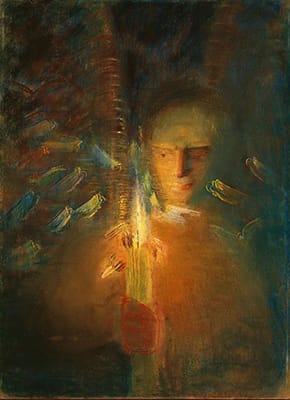
Truth
Cited by some as the artist's greatest masterpiece, Truth represents Čiurlionis's fascination with symbolism, the meeting of natural and supernatural worlds, and his proud Lithuanian heritage. Truth is an obscured visage of a male figure holding a candle in his right hand. The warm light from the flame casts harsh shadows over the subject's eyes and nose, heightening the sense of deep concentration in the furrow of his brow. The man looks on pensively, as if contemplating the search for truths within the flame's illumination. But rather than provide clarity, the light obscures both the subject and his surroundings. The gestural swipes of color hover at eye level with the subject, filling his field of vision and the middle register of the painting. The bright orange light contrasts with the deep hues of red and green that form the background. Small flying creatures, thought to be angels, are depicted flying towards the flame and perishing as their wings are burned upon contact.
Čiurlionis's keen interest in contemporary psychological and philosophical movements informed his exploration of the self and abstract concepts of emotion and human connection. Truth is one of several works with titles references abstract concepts such as friendship, thought and sorrow. Čiurlionis aimed to personify these universal concepts in vivid color in order to understand their relation to his other interests of folklore, mythology and religion. The towering, tree-like forms at the painting's center represent the artist's - and his audience's - search for enlightenment and spiritual truth. The celestial orbs hint at cosmic forces, while the flowing lines and gentle curves suggest the rhythms of nature.
Pastel on paper
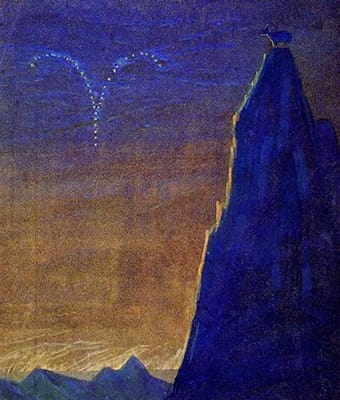
The Sun is Passing the Sign of Aries
The Zodiac cycles are most unique in Čiurlionis's oeuvre because of their depiction of independent images as opposed to the linear progression of a theme or story (as, for instance, in his Creation of the World I. from the cycle of 13 paintings (1905-06)). The continuity here can be found in the gliding movement of the sun across the sky in all twelve paintings. Each work contains the astrological symbol of the zodiac as well as the animal or symbol most closely associated with that sign. Čiurlionis's preoccupation with astronomy was deeply influenced by the work of the French astronomer Camille Flammarion who's published works broadened the accessibility of celestial knowledge and ideas. Indeed, Čiurlionis was deeply entranced by the night sky and its place in folklore, mythology, and science. These works signal the beginning of Čiurlionis's mature period. His forms are becoming more expressive and monumental while the color palette and handling of the paint is more nuanced; the ethereality of both the figures and scenery is pronounced.
Like the rest of the Zodiac series, The Sun is Passing the Sign of Aries has a highly-contrasted foreground and background that draws the viewer's attention through the image. On the right-hand side there is an enormous jutting cliffside with a ram, the symbol of Aries, proudly silhouetted at its peak. There is a set of distant mountains in the bottom left register of the image, rendered in a lighter more atmospheric blue to emphasize their distance from the viewer. The mountain and ram are cast in deep blue and black shadow with a fine yellow highlight across their left sides. The trace of yellow cascades from the distant mountain range up to the stately ram, leading the viewer's eye to the V-shaped symbol of Aries made of dotted stars in the darkening night sky. The last reaches of sunlight pepper the surrounding clouds, complementing the highlights and shadows of the mountain range.
Tempera on paper
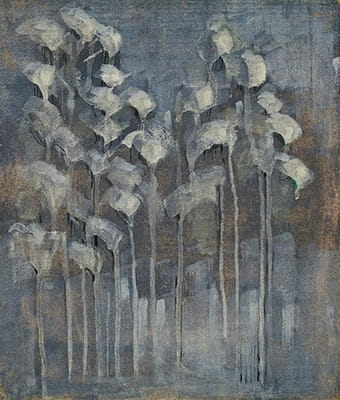
Winter
Čiurlionis abandons the linear narrative of the cycles (once more) in favor of exploring the recurring motif of the tree. The thread between the images is one of a continuity of color, mood, and aesthetic. Čiurlionis had fully entered his mature period (despite being just 28 years of age) and was bolder in his abandonment of concrete imagery. He imbued these images of trees in varying snowy landscapes with the symbolism of purity, rebirth, and quiet contemplation. Each painting in the cycle is evocative of a different meditative and symbolic state, from the joyful to the solitary. The works represent a convergence between landscape and pure abstraction.
Winter depicts an evergreen tree caked with fresh snow. There are glimpses of the green needles of the tree peeking out from underneath the swathes of snow on the branches. There is a palpable weight to the branches; the direct application of paint implying a heavy blanketing of fresh snow. While there is recognizable imagery in the trees, the scene as a whole seems somewhat abstract. Čiurlionis's handling of the tempera is loose, allowing the liquidity of the tempera to glide down the length of the painting emulating dripping icicles and snow. The natural color of the paper shows through, melding into the cool, pale white of the snow and creating an overall low contrast palette.
The official Čiurlionis website states: "The 'Winter' cycle is one of Čiurlionis' most masterful creations in terms of plasticity. By manipulating specific natural elements, the artist transforms them into generalized symbols or metaphors, thus these eight paintings can be called abstract improvisations. These are free-style compositions that abstract the states of nature in winter - temporary, constantly changing and uniquely different each time. There is no literal narrative in this cycle, thus the paintings are united by a common colour palette, idea, and mood. The motif of a tree receives the most attention in the artist's improvisations, resulting in several variations of depicting trees".
Tempera on paper
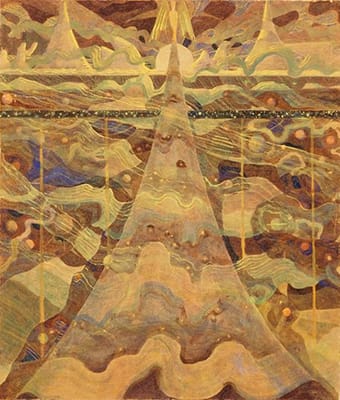
Sonata No. 6 (Sonata of the Stars). Allegro
It was Čiurlionis's keen interest in astronomy that inspired the creation of Sonata of the Stars. He created a total of seven Sonata in this series: each celebrating seasons, celestial bodies, and/or metaphysical symbols. Allegro, embodies Čiurlionis's mystical perception of outer space. Titled after the Italian musical term, Allegro is vibrant and energetic (while another in the series, Andante, is slower and more contemplative). The eponymous musical term reflects Čiurlionis's belief in a universal symphony. The musicality of the composition can be seen in the cohesive hues, tones, and in its symbolism. But while rhythm is key to Allegro, historian Rasa Andriušytė-Žukienė observes that the artist "did not 'paint music', but rather with composer's expertise adopted plastic equivalents of musical means of expression: rhythm of line and plane, flexibly waving forms, 'overlapping' of several levels of landscape creating an effect of expanded space".
Oceanic whorls cascade throughout the composition, creating a sense of unity in chaos. There is a strong vertical symmetry disrupted by liquid infusions of ethereal movement. The central shape descends from the abstracted image of an angel at the top of the page. This angel's image, meanwhile, is propelled out of frame from the energy of the sky below. Čiurlionis layers the tempera to create rich, complex color. Overall, the scene is rendered in golds, warm browns, reds and deep blues. Depictions of stars, planets and nebulae, meanwhile, are scattered in the lower three quarters of the painting. At the top, there is a refined golden mountain range silhouetted against a setting sun. Andriušytė-Žukienė concludes, "Čiurlionis' painting was rendered more abstract by the application of the structural and compositional elements of music. Nevertheless, none of the so-called 'musical' paintings could ever be considered a totally abstract work of art, for he was always concerned with idea of the cycle, its 'plot' communicated through symbolic links between separate motifs. The ideas of his paintings are generalised (journey, creation of the world, ruler of the world, element of nature, cosmic order), linked with mythology, Lithuanian legends, fairy tales and folklore".
Tempera on paper
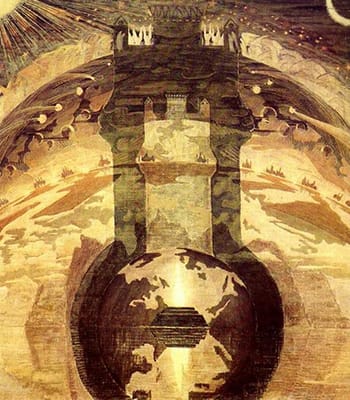
Rex
Curator Kathleen Soriano writes, "In 1387, Lithuania became the last European country to adopt Christianity. Previously it had embraced paganism and pantheism, worshipping the natural world. The legacy of these beliefs was perpetuated in Lithuanian mythology and folklore, strongly influencing Čiurlionis' art, as evidenced in works such as Rex, where a God-like figure, or Fairy King, appears to create 'man'. These early depictions of 'Rex', the omnipotent creator, spirit and protector, will go on to populate many of Čiurlionis's paintings".
This painting is Čiurlionis's largest, and perhaps most iconic, work. He included motifs and symbols such as "Rex" who represents the complex amalgamation of gods from different religions. The natural elements of fire, water, earth, and air are represented in equal parts, achieving harmonic balance in the composition. Drawing again from the work of French astronomer Flammarion, Čiurlionis sought to represent the different planes of existence within a seemingly endless multitude of worlds. He succeeded in depicting these different stages of the spiritual journey chiefly through a duality of light and dark.
Duality can be seen in fact in all aspects of the composition. The light and dark coloration, the symbols of day and night, and the mirroring along the vertical and horizontal axis, generates a strong sense of symmetry. The eternal flame can be seen burning in an altar reflecting against a mirrored liquid surface, thereby creating a complete Earth-like orb. Meahwhile, the center of the composition is dominated, by an architectural throne, atop which, sits Rex; his pale throne encased by its shadow, reflecting his crown against a tempestuous sky. There are subsequent layers of distant mountains which are symbolic of both literal and metaphoric journeys. Celestial bodies can be seen in each top corner with the sun rising in the left and the crescent moon rising on the right, while cascading angelic figures and shooting stars form a divide between the celestial and the worldly.
Tempera on canvas
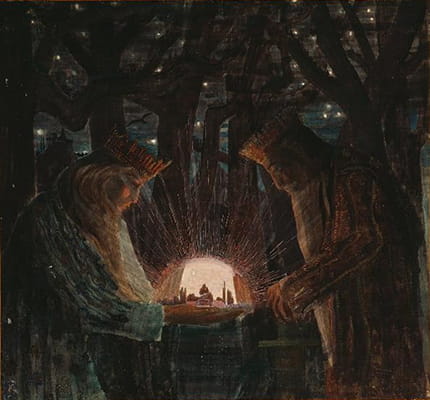
Fairy Tale (Fairy Tale of the Kings)
Despite his many influences, Čiurlionis felt the importance of Lithuanian folklore and culture most keenly in his later works. Fairy Tale (Fairy Tale of the Kings) represents a convergence between classical Lithuanian stories and the Symbolist worldview he took onboard during his travels and studies. In pre-Christian Lithuanian mythology, elements of nature were especially revered. The literal central presence of the pristine farmland in the central dome reinforces here the importance of the richness of the land. The dark, intense, palette is immediately striking. Two figures - likely two kings or a king and a queen - are seen looming over a small civilization contained under a glowing dome. Striations of light radiate outwards, evoking the style of Medieval halos and mandorlas. The royals' robes are heavy and intricately adorned in red and blue embroidery. Their crowns are equally bejeweled in precious stones that reflect the light emanating from the dome. The trees, meanwhile, are illuminated with glowing starlight peppered through the tree branches. This isolated light reveals the outlines of buildings and active animals in the distance.
Historian Greta Katkeviciene says of the work, "The Lithuanian countryside (as well as nature) was very important to the artist and the folklore coming from it dictated a lot of the topics for his paintings. He even wrote in one of his articles that Lithuanian folk art should be the proud base for national art. Why? Because there is nothing more Lithuanian than folklore and folk art that comes from it. Knowing that this article came at a time when Lithuanians were trying to find their identity under the Russian empire, the notion of defining Lithuanian art was more than important - it was necessary in order to unite and guide the Lithuanian art movement".
Tempera on canvas
Biography of Mikalojus Konstantinas Čiurlionis
Childhood
Mikalojus Konstantinas Čiurlionis (MK Čiurlionis), the eldest of nine siblings, was born into a Polish-speaking family in Varena, Southern Lithuania, in 1875. His father, Konstantinas Čiurlionis, was a prominent choirmaster and organist. His mother, Adelė (née Radmanaitė) possessed an encyclopedic-like knowledge of Lithuanian songs and legends. Mikalojus would be the first son and heir of his parents' love of music and Lithuanian folklore.
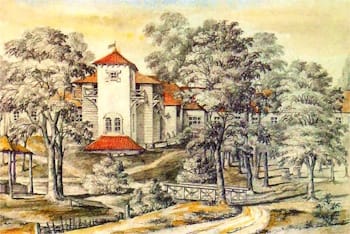
When Čiurlionis was three years old, the family relocated to the picturesque town of Druskininkai (in southern Lithuania) where his father took up the post of town organist. Even at this young age, Čiurlionis was showing a prodigious aptitude for music. Schooled by his parents, he played piano in the family home and had mastered the ability to play by ear, and sight read sheet music, by the time he was seven years old. His talent attracted the attention of a family friend, Dr. Jozef Markiewicz, who recommended Čiurlionis to Prince Michał Kleofas Ogiński, a Polish diplomat and senator to Tsar Alexander I, who ran a musical school and conservatory in the neighboring city of Plungė.
Education and Early Training
Čiurlionis was enrolled in the Plungė Palace Orchestra School between 1889 and 1893. Still in his early teenage years, the youth expanded his compositional skills by learning flute and studying music theory. As a member of the school's orchestra, Čiurlionis traveled and performed in cities such as Palanga, Riga and Rietava. Prince Ogiński, an enthusiastic Romantic composer himself, was so impressed by Čiurlionis's musical talents he offered to become his patron. Ogiński provided Čiurlionis with a scholarship to further his study in Poland at the Warsaw Institute of Music which he attended between 1894 and 1899. Curator Kathleen Soriano has stressed the importance of understanding the geo-political context in which Čiurlionis was performing. She notes that in the late eighteenth-century, Lithuania was connected to Poland before falling under the control of Russia. Under Russian law, the teaching of the Lithuanian language (and the Latin alphabet) was banned in junior schools with books forbidden to be printed in Lithuanian. Furthermore, the famine of the 1860s saw approximately 20% of the Lithuanian population emigrate, most of them to the United States. Soriano writes, "the strength of the distinctive Lithuanian culture and customs, its folklore and mythology, was preserved, largely by the peasant classes [and over time] a nationalist revival grew, with Čiurlionis himself becoming a great champion of independence from the 1890s".
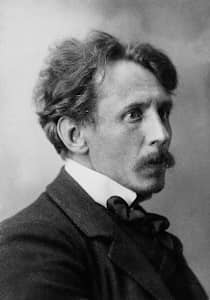
Čiurlionis was also able to explore a range of other subjects in Warsaw. In addition to musical harmony, theory and history (which he studied under highly regarded professors T. Brezicki, Anton Sygietinski and Zygmunt Noskowski), he learned about natural sciences, astronomy, philosophy, numismatics and mineralogy. The depth and breadth of Čiurlionis's education allowed him to expand his approach to composition. His earliest efforts were highly ambitious, earning him admiration from his professors and peers. He also devoured the literary works of authors of the standing Dostoyevsky, Nietzsche and Tolstoy. During this period Čiurlionis met fellow student (and future composer, pedagogue and painter) Eugeniusz Morawski-Dąbrowa. The pair became close friends and delighted in their shared pursuit of new insights into aesthetics and art.
Despite the many plaudits and laurels he received at the Institute, Čiurlionis showed his strong independent spirit by turning down a prestigious offer to become the orchestra master for Lublin's Music Society Choir. During the years after his graduation, Čiurlionis wrote his first symphonic poem, In the Forest (1899), which he dedicated to Morawski-Dabrowa. A subgenre of the Romanticism movement, symphonic poems, which aimed to elicit emotional responses from the listener, were imbued with literary and even mystical influences. Čiurlionis's symphonic poems would become harbingers for his later paintings in the way they captured the beauty and mysticism of the natural world. Čiurlionis also taught private music lessons in Warsaw between 1899 and 1901 as a means of financially supporting himself and his brother who had also enrolled at the Institute of Music.
After receiving a further stipend from Prince Ogiński, Čiurlionis attended the Leipzig Conservatoire in 1901. He studied under Professor Carl Reinecke and Salomon Jadassohn. Fueled by an interests seeded in his studies in Warsaw, Čiurlionis attended lectures in aesthetics, history and psychology (in addition to his music and composition courses). When Ogiński died suddenly in 1902, Čiurlionis's generous financial support stopped, but Čiurlionis managed to finish his work at the Conservatory (and in the process earning a recognized teaching qualification). His lack of proficiency in German, and the distance from friends and loved ones in Lithuania, however, caused Čiurlionis great sorrow and he turned increasingly towards drawing and painting as a therapeutic outlet. Čiurlionis first artistic efforts were painted postcards which he sent to his brother Povilas. He wrote on the reverse of one postcard featuring a drawing of two lighthouses that doubled as human eyes: "I like serenity, but today I cannot stand it. It seems like someone is snooping. Scary. an idea came to my mind that in this serenity there is an important secret [...] Now serenity makes the impression of a grand pause [...] The past has disappeared, the future is no longer there, and the present - pause - nothing. imagine that, if you will".
In 1904 Čiurlionis returned to Warsaw and enrolled in the Warsaw School of Fine Arts where he attended for two years. He studied under many esteemed professors and artists who nurtured his interest in theosophy and esoteric thought. But it was the Lithuanian Symbolist painter Kazimieras Stabrauskas who exerted the most profound influence over Čiurlionis. His inclination towards abstraction, meanwhile, was rooted in Western Europe, but more so, perhaps, in stories of creation, otherworldly deities, and mystical imagery, found in Lithuanian folklore.
Historian Rasa Andriušytė-Žukienė observes that early works, such as Danger 1904, The Rustling of the Forest (1904), and The Piper (1904) "are dominated by images of night, dusk and sunset. Secrets lurking in the dusk, the elegy of nature, inexplicable human fears and strange modes from tender lyricism to fatalistic horror are blended together here". She adds that "Animisation, a popular principle of Symbolism, in which natural forms, such as a mountain, a bell, a cloud, the tops of the trees, are painted so as to be reminiscent of human or animal forms, is frequently employed in his paintings" such as Day (1904) and Serenity (1904).
Čiurlionis had also taken a keen interest in aspects of Medieval art. His preference for painting in tempera, with his cycles, diptychs and triptychs, were directly influenced by religious panel paintings, for instance. His flat picture planes, with their skewed and slightly tilted perspectives, and cascading narratives appearing in distant sections or tiers of the painting, meanwhile, all found their precedence in early Medieval art. Later paintings would bear stronger musical influence and were even named after musical notations and structures such as sonata, allegro, andante, scherzo, and finale. Čiurlionis had dabbled in drawing and painting while at school in Plungė, but his interests in the visual arts finally took over in Warsaw. Indeed, the 27-year-old Čiurlionis was so consumed by his artistic studies that he rejected Polish conductor and composer Emili Młynarski's offer to teach at the Warsaw Institute of Music. Yet while his professional aspirations might have firmly shifted focus, he continued to support his commitment to his music education by composing music and giving private lessons.
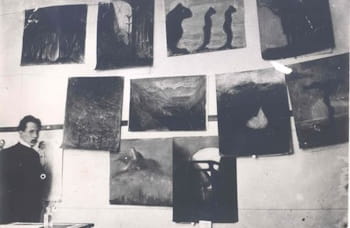
The years 1903 through 1909 would prove to be the most creative and productive in Čiurlionis's life as a painter. In 1903, he created his first cycle of seven works, Funeral Symphony. While all of the works contain perceptible imagery and scenery, they are rich with symbolism and a strong inclination towards simplification of form. The use of pastels on paper and the restricted color palette of yellows, blues and greens, meanwhile, created a hazy, dreamy atmosphere that would provide the foundation for Čiurlionis's expansion into abstraction. Between 1904 and 1905, he was participating in prestigious school exhibitions, including the first annual exhibition of Warsaw School of Arts (in 1905).
While privately tutoring her children, Čiurlionis and Bronisława Wolman became close friends, and she assumed the role of his patron. In the summers of 1905 and 1906, they traveled with the friends and family of Wolman to the Black Sea and Caucasus Mountains. Čiurlionis was greatly inspired by these striking sea and landscapes. Wolman funded Čiurlionis's travels to the cultural capitals of Europe. He traveled to Dresden, Munich, Nuremberg, Prague, and Vienna to view the works of artists he admired such as Anthony van Dyck, Rembrandt, and especially the Swiss Symbolist, Arnold Böcklin. (Such was his gratitude to Wolman's financial support, Čiurlionis gifted her many of his paintings.)
Čiurlionis exhibited in St. Petersburg in May 1906, with (what would become) signature paintings, such as A Day (1904), Storm (1904), the diptych Rex (1905), and Creation of the World (1905/06) (one of 13 in this cycle). Curator Kathleen Soriano argues that "Despite his protestations, [these works] are clearly associated with the Bible's creation story while referencing ancient texts such as the Indian Vedas, as well as showing knowledge of new theories of evolution and his interest in writers on the subject of our relationship with nature and the universe". Čiurlionis earned his first significant professional acclaim in June 1906 with a feature on Creation of the World in Vilniaus žinios No. 123, an illustrious national newspaper published in the Lithuanian capital.
Mature Period
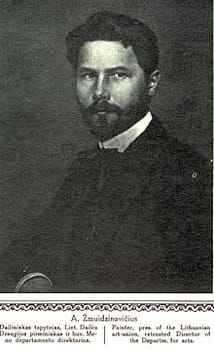
In 1907 Čiurlionis moved to Vilnius where he soon found himself into the cultural hub of the city. He was one of the founders of the Lithuanian Artist Society (the LSA's objective was to further establish a coherent Lithuanian identity through the arts) and helped put on the first Lithuanian Art Exhibition (showcasing work by Čiurlionis and the painter and art collector, Antanas Žmuidzinavičius) at the Vileišis Palace. (Despite his growing profile, Čiurlionis was not happy with all his exhibited works. Writing to Wolman, he stated: "I have 8 pieces for my 'Summer' series, half of which will most probably find themselves in the fire".) By the end on 1907, Čiurlionis had completed over 50 paintings (not to mention many symphonic poems).
Čiurlionis had by now commenced painting his "pictorial sonatas" (naming them only by number - 1 to 7 - before later adding names such as Sonata of Spring; Sonata of Serpent and Sonata of the Pyramids). His sonatas represented the artist's unique take on the idea of synesthesia. As Andriušytė-Žukienė explains, "He united various motifs from reality, different spatial levels and moments in time, as well as contrasting symbolic images into a single compositional system (cycle), based on the dynamics of the rhythm (Allegro, Andante, Scherzo, Finale). Čiurlionis created a certain system for synthesising the principles of music and painting, based on generic correspondence: the volume of musical sound corresponds to the intensity of colour and outline, musical tempo corresponds to the plastic-linear rhythm, whereas the particular part of the musical composition corresponds to the position of a painting within the cyclical structure".
In 1908 Čiurlionis began writing for the Lithuanian-language newspaper, Viltis (Hope). It was in the pages of Viltis that he expressed his long-term plan to create a grandiose building - which he called "House of the Nation" - that would incorporate a museum, concert hall, exhibition space and a library. (The artist's "dream" was realized after his death in 1921 with the opening of the M. K. Čiurlionis National Museum of Art; today one of the oldest and largest art museums in Lithuania.) But perhaps his most significant moment of 1908 (certainly from a personal point of view) came when he met the writer, and soon-to-be wife, Sofija Kymantaitė-Čiurlionienė. The pair shared an impressive artistic synergy and were dedicated to establishing a uniquely modern Lithuanian culture. Indeed, Sofija reinvigorated Čiurlionis's love for his home country and fuelled his growing fixation on Lithuanian folklore.
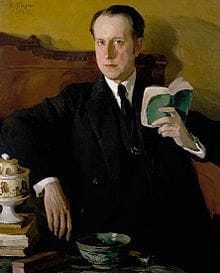
In 1908, Čiurlionis and Sofija were instrumental in the organization of the Second Exhibition of Lithuanian Art in Vilnius and Kaunas, while the artist continued to paint, and compose and perform music, in Vilnius and the famous spa resort of Druskininkai. With his star in the ascendency, Čiurlionis moved to St. Petersburg in the autumn of 1908. Immersing himself in the contemporary Russian arts scene, Čiurlionis met the graphic and theater artist Mstislav Dobuzhinsky (also of Lithuanian origin) who introduced his compatriot to the Russian Artist Society.
1909 would prove to be the apex of Čiurlionis's career. The year started with his marriage to Sofija (on January 1). After visiting their respective families (in Lithuania), the newlyweds divided their time between Vilnius and St. Petersburg. Čiurlionis was gaining greater exposure, establishing numerous connections in Russia and participating in prestigious exhibitions. Čiurlionis's style matured in line with his growing reputation. Perhaps his most recognizable and quintessentially symbolist work was Rex (1909). Painted in St. Petersburg, it would become the largest painting in his oeuvre. The work was a synthesis of his studies and interests in esoteric thought, astronomy, music and other sciences. It referenced, in fact, earlier works of the same title that depict "Rex" as an amalgamation of different religions gods and creation stories, emphasizing connection to universal ruler and spirit of the world. The latest work also referenced Čiurlionis's tour of the Caucasus Mountains with Bronisława Wolman and her family. Many of his paintings (including Rex) were exhibited in the Sixth Exhibition of Russian Artist Society, the First Spring Exhibition of Vilnius Artist Society, and the Thirteenth Art Lover Society "Sztuka" Exhibition in Krakow, Poland.
Late Period
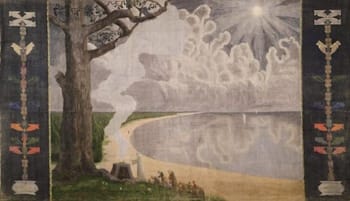
By the end of 1909, Čiurlionis was beginning to suffer from exhaustion. He and Vilnius aided in the organization of the Third Art Exhibition of Lithuanian Art, while Čiurlionis even painted the stage curtain for the newly formed Rūta Society (the Society was a cultural society located in Vilnius that staged events, including plays, musical performances and recitals, lectures, and literary evenings). Despite his exhaustive state, Čiurlionis continued with his push to invigorate the city's cultural standing. Sofija became increasingly concerned for her husband's health after he began acting erratically during the Christmas holiday. On the advice of a psychologist, the couple moved to Druskininkai in early 1910, before Čiurlionis entered a new period of rehabilitation in a health resort in Marki, Poland. While there, Sofija gave birth to their first and only daughter, Danutė.
Čiurlionis was invited to the second (of three) Neue Künstlervereinigung München exhibition in 1910, organized by a committee of Wassily Kandinsky, Alexander Kanoldt, and Adolf Erbslöh. The second exhibition would have seen his work stand next to pieces by members of Europe's avant-garde such as David and Vladimir Burliuks, Le Fauconnier, Picasso, Rouault, Braque, Derain, van Dongen and Vlaminck. But in a blow to his burgeoning reputation, Čiurlionis was still too weakened by his illness to participate in the exhibition. Čiurlionis was making a slow but steady recovery (and even began painting and composing again) when, in the spring of 1911, he contracted pneumonia while on a walk. Given his weakened immunity, Čiurlionis succumbed to the illness and died on April 10, 1911, aged just 35 (and having never met his daughter).
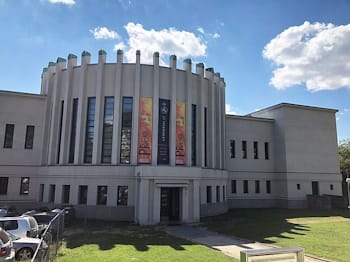
Opened ten years after his death (and fully renovated in 2003), the M. K. Čiurlionis National Museum of Art is today one of the oldest and largest art museums and music halls in Lithuania. With a full calendar of cultural events, performances and conferences, it is the permanent home to the largest single collection of his works. The Lithuanian Art Society's has become a custodian of his works while the Vileišis Palace is dedicated to securing his legacy through regular events and exhibitions.
The Legacy of Mikalojus Konstantinas Čiurlionis
Although he was on the very cusp of joining the ranks of the leading players of the Western avant-garde, Čiurlionis's untimely passing meant that familiarity with his art remained largely restricted to a small corner of Eastern Europe. Even after his death, his family was initially reluctant to allow his artworks (dozens of which remained unfinished in any case) to leave Lithuania. But while Čiurlionis preferred to work with tempera and watercolor on paper (raising fears about his works being damaged in transit), improvements in restoration and art handling saw a noticeable spike in the international exhibition of his art during the 1950s. But if Čiurlionis's supporting position in the annuls of Western modernism can be directly attributed to these factors, he has remained a leading protagonist in Lithuania's modern cultural identity.
In addition to over 300 drawings and paintings, Čiurlionis created some 400-plus musical compositions (almost half of which are for the piano). He belongs in the company of other great composers who became visual artists, most notably, perhaps, Wassily Kandinsky. As art critic Aleksis Rannit observes, "Čiurlionis is the first abstract painter and yet few knew it. [Kandinsky] only painted his first abstract work in 1911. But already in 1904, Čiurlionis gave the world a body of work that we must class as abstract, of semi-abstract painting". Soriano adds, "His body of work has an intensity of vision and, at its heart, aims to transcend different worlds, to reach higher, mystical planes where art and music, abstraction and figuration, light and dark, calm and chaos, nature and the spiritual, exist in harmony".
Influences and Connections

-
![Anthony Van Dyck]() Anthony Van Dyck
Anthony Van Dyck -
![Rembrandt van Rijn]() Rembrandt van Rijn
Rembrandt van Rijn -
![Arnold Bocklin]() Arnold Bocklin
Arnold Bocklin - Kazimieras Stabrauskas
- Eugeniusz Morawski-Dąbrowa
- Kazimieras Stabrauskas
- Sofija Kymantaitė
-
![Romanticism]() Romanticism
Romanticism -
![Symbolism]() Symbolism
Symbolism ![Folk Art]() Folk Art
Folk Art
-
![Kazimir Malevich]() Kazimir Malevich
Kazimir Malevich ![Igor Stravinsky]() Igor Stravinsky
Igor Stravinsky
- Eugeniusz Morawski-Dąbrowa
- Kazimieras Stabrauskas
- Sofija Kymantaitė
 Ask The Art Story AI
Ask The Art Story AI